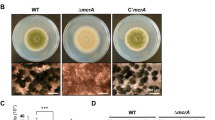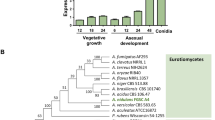Abstract
Multiple transcriptional regulators play important roles in the coordination of developmental processes, including asexual and sexual development, and secondary metabolism in the filamentous fungus Aspergillus nidulans. In the present study, we characterized a novel putative C2H2-type transcription factor (TF), RocA, in relation to development and secondary metabolism. Deletion of rocA increased conidiation and caused defective sexual development. In contrast, the overexpression of rocA exerted opposite effects on both phenotypes. Additionally, nullifying rocA resulted in enhanced brlA expression and reduced nsdC expression, whereas its overexpression exerted the opposite effects. These results suggest that RocA functions as a negative regulator of asexual development by repressing the expression of brlA encoding a key asexual development activator, but as a positive regulator of sexual development by enhancing the expression of nsdC encoding a pivotal sexual development activator. Deletion of rocA increased the production of sterigmatocystin (ST), as well as the expression of its biosynthetic genes, aflR and stcU. Additionally, the expression of the biosynthetic genes for penicillin (PN), ipnA and acvA, and for terrequinone (TQ), tdiB and tdiE, was increased by rocA deletion. Thus, it appears that RocA functions as a negative transcriptional modulator of the secondary metabolic genes involved in ST, PN, and TQ biosynthesis. Taken together, we propose that RocA is a novel transcriptional regulator that may act either positively or negatively at multiple target genes necessary for asexual and sexual development and secondary metabolism.
Similar content being viewed by others

References
Adams, T.H., Boylan, M.T., and Timberlake, W.E. 1988. brlA is necessary and sufficient to direct conidiophore development in Aspergillus nidulans. Cell54, 353–362.
Adams, T.H., Deising, H., and Timberlake, W.E. 1990. brlA requires both zinc fingers to induce development. Mol. Cell Biol.10, 1815–1817.
Adams, T.H., Wieser, J.K., and Yu, J.H. 1998. Asexual sporulation in Aspergillus nidulans. Microbiol. Mol. Biol. Rev.62, 35–54.
Ahmed, Y.L., Gerke, J., Park, H.S., Bayram, Ö., Neumann, P., Ni, M., Dickmanns, A., Kim, S.C., Yu, J.H., Braus, G.H., et al. 2013. The velvet family of fungal regulators contains a DNA-binding domain structurally similar to NF-κB. PLoS Biol.11, e1001750.
Aramayo, R. and Timberlake, W.E. 1993. The Aspergillus nidulans yA gene is regulated by abaA. EMBO J.12, 2039–2048.
Bayram, O. and Braus, G.H. 2012. Coordination of secondary metabolism and development in fungi: the velvet family of regulatory proteins. FEMS Microbiol. Rev.36, 1–24.
Bayram, O., Krappmann, S., Ni, M., Bok, J.W., Helmstaedt, K., Valerius, O., Braus-Stromeyer, S., Kwon, N.J., Keller, N.P., Yu, J.H., et al. 2008. VelB/VeA/LaeA complex coordinates light signal with fungal development and secondary metabolism. Science320, 1504–1506.
Bok, J.W. and Keller, N.P. 2004. LaeA, a regulator of secondary metabolism in Aspergillus spp. Eukaryot. Cell3, 527–535.
Borneman, A.R., Hynes, M.J., and Andrianopoulos, A. 2001. An STE12 homolog from the asexual, dimorphic fungus Penicillium marneffei complements the defect in sexual development of an Aspergillus nidulans steA mutant. Genetics157, 1003–1014.
Bouhired, S., Weber, M., Kempf-Sontag, A., Keller, N.P., and Hoffmeister, D. 2007. Accurate prediction of the Aspergillus nidulans terrequinone gene cluster boundaries using the transcriptional regulator LaeA. Fungal Genet. Biol.44, 1134–1145.
Boylan, M.T., Mirabito, P.M., Willett, C.E., Zimmerman, C.R., and Timberlake, W.E. 1987. Isolation and physical characterization of three essential conidiation genes from Aspergillus nidulans. Mol. Cell Biol.7, 3113–3118.
Calvo, A.M., Wilson, R.A., Bok, J.W., and Keller, N.P. 2002. Relationship between secondary metabolism and fungal development. Microbiol. Mol. Biol. Rev.66, 447–459.
Chen, Y., Leal, A.D., Patel, S., and Gorski, D.H. 2007. The homeobox gene GAX activates p21WAF1/CIP1 expression in vascular endothelial cells through direct interaction with upstream AT-rich sequences. J. Biol. Chem.282, 507–517.
Douville, J.M., Cheung, D.Y., Herbert, K.L., Moffatt, T., and Wigle, J.T. 2011. Mechanisms of MEOX1 and MEOX2 regulation of the cyclin dependent kinase inhibitors p21CIP1/WAF1 and p16INK4a in vascular endothelial cells. PLoS One6, e29099.
Dyer, P.S. and O’Gorman, C.M. 2012. Sexual development and cryptic sexuality in fungi: insights from Aspergillus species. FEMS Microbiol. Rev.36, 165–192.
Fernandes, M., Keller, N.P., and Adams, T.H. 1998. Sequence-specific binding by Aspergillus nidulans AflR, a C6 zinc cluster protein regulating mycotoxin biosynthesis. Mol. Microbiol.28, 1355–1365.
Han, K.H. 2009. Molecular genetics of Emericella nidulans sexual development. Mycobiology37, 171–182.
Han, K.H., Han, K.Y., Yu, J.H., Chae, K.S., Jahng, K.Y., and Han, D.M. 2001. The nsdD gene encodes a putative GATA-type transcription factor necessary for sexual development of Aspergillus nidulans. Mol. Microbiol.41, 299–309.
Kim, H.R., Chae, K.S., Han, K.H., and Han, D.M. 2009. The nsdC gene encoding a putative C2H2-type transcription factor is a key activator of sexual development in Aspergillus nidulans. Genetics182, 771–783.
Kim, H., Han, K., Kim, K., Han, D., Jahng, K., and Chae, K. 2002. The veA gene activates sexual development in Aspergillus nidulans. Fungal Genet. Biol.37, 72–80.
Kim, Y.J., Yu, Y.M., and Maeng, P.J. 2017. Differential control of asexual development and sterigmatocystin biosynthesis by a novel regulator in Aspergillus nidulans. Sci. Rep.7, 46340.
Kwon, N.J., Garzia, A., Espeso, E.A., Ugalde, U., and Yu, J.H. 2010. FlbC is a putative nuclear C2H2 transcription factor regulating development in Aspergillus nidulans. Mol. Microbiol.77, 1203–1219.
Lee, B.N. and Adams, T.H. 1996. fluG and flbA function interdependently to initiate conidiophore development in Aspergillus nidulans through brlAβ activation. EMBO J.15, 299–309.
Lee, M.K., Kwon, N.J., Choi, J.M., Lee, I.S., Jung, S., and Yu, J.H. 2014. NsdD is a key repressor of asexual development in Aspergillus nidulans. Genetics197, 159–173.
Marshall, M.A. and Timberlake, W.E. 1991. Aspergillus nidulans wetA activates spore-specific gene expression. Mol. Cell Biol.11, 55–62.
Nguyen Ba, A.N., Pogoutse, A., Provart, N., and Moses, A.M. 2009. NLStradamus: a simple hidden markov model for nuclear localization signal prediction. BMC Bioinformatics10, 202.
Paraguison, R.C., Higaki, K., Sakamoto, Y., Hashimoto, O., Miyake, N., Matsumoto, H., Yamamoto, K., Sasaki, T., Kato, N., and Nanba, E. 2005. Polyhistidine tract expansions in HOXA1 result in intranuclear aggregation and increased cell death. Biochem. Biophys. Res. Commun.336, 1033–1039.
Park, H.S., Nam, T.Y., Han, K.H., Kim, S.C., and Yu, J.H. 2014. VelC positively controls sexual development in Aspergillus nidulans. PLoS One9, e89883.
Park, D.S., Yu, Y.M., Kim, Y.J., and Maeng, P.J. 2015. Negative regulation of the vacuole-mediated resistance to K+ stress by a novel C2H2 zinc finger transcription factor encoded by aslA in Aspergillus nidulans. J. Microbiol.53, 100–110.
Ramamoorthy, V., Dhingra, S., Kincaid, A., Shantappa, S., Feng, X., and Calvo, A.M. 2013. The putative C2H2 transcription factor MtfA is a novel regulator of secondary metabolism and morphogenesis in Aspergillus nidulans. PLoS One8, e74122.
Sambrook, J. and Russell, D.W. 2001. Molecular cloning: A laboratory manual. Cold Spring Harbor Laboratory Press, New York, USA.
Seo, J.A., Guan, Y., and Yu, J.H. 2003. Suppressor mutations bypass the requirement of fluG for asexual sporulation and sterigmatocystin production in Aspergillus nidulans. Genetics165, 1083–1093.
Seo, J.A., Guan, Y., and Yu, J.H. 2006. FluG-dependent asexual development in Aspergillus nidulans occurs via derepression. Genetics172, 1535–1544.
Yelton, M.M., Hamer, J.E., and Timberlake, W.E. 1984. Transformation of Aspergillus nidulans by using a trpC plasmid. Proc. Natl. Acad. Sci. USA81, 1470–1474.
Yu, Y.M. 2015. Genome-wide analysis reveals the transcriptional programs on the whole process from germination to differentiation in Aspergillus nidulans. Ph. D. thesis. Chungnam National University, Daejeon, Korea.
Yu, J.H., Hamari, Z., Han, K.H., Seo, J.A., Reyes-Dominguez, Y., and Scazzocchio, C. 2004. Double-joint PCR: a PCR-based molecular tool for gene manipulations in filamentous fungi. Fungal Genet. Biol.41, 973–981.
Acknowledgments
This work was supported by the grants from the NRF of Korea, NRF-2018R1D1A1B07043688 and 2017R1A6A3A-01076516.
Author information
Authors and Affiliations
Corresponding authors
Additional information
Supplemental material for this article may be found at http://www.springerlink.com/content/120956
Electronic supplementary material
Rights and permissions
About this article
Cite this article
Won, D.C., Kim, Y.J., Kim, D.H. et al. The putative C2H2 transcription factor RocA is a novel regulator of development and secondary metabolism in Aspergillus nidulans. J Microbiol. 58, 574–587 (2020). https://doi.org/10.1007/s12275-020-0083-7
Received:
Revised:
Accepted:
Published:
Issue Date:
DOI: https://doi.org/10.1007/s12275-020-0083-7



